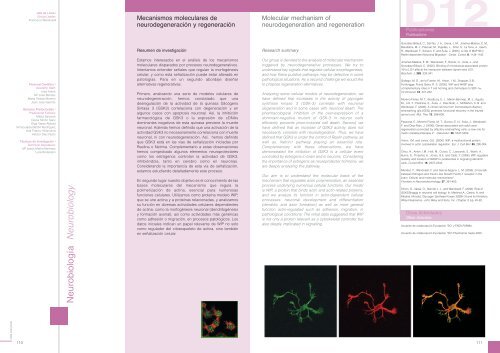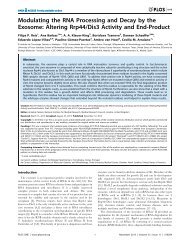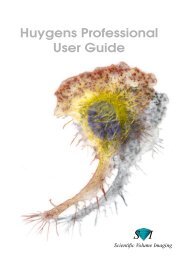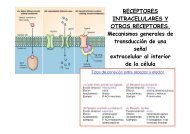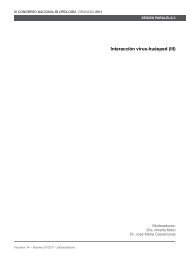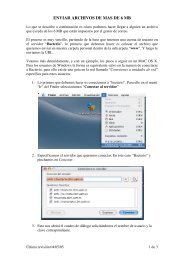Drosophila - Severo Ochoa - Universidad Autónoma de Madrid
Drosophila - Severo Ochoa - Universidad Autónoma de Madrid
Drosophila - Severo Ochoa - Universidad Autónoma de Madrid
You also want an ePaper? Increase the reach of your titles
YUMPU automatically turns print PDFs into web optimized ePapers that Google loves.
Jefe <strong>de</strong> Línea /<br />
Group Lea<strong>de</strong>r:<br />
Francisco Wandosell<br />
Mecanismos moleculares <strong>de</strong><br />
neuro<strong>de</strong>generación y regeneración<br />
Molecular mechanism of<br />
neuro<strong>de</strong>generation and regeneration<br />
D12<br />
Publicaciones<br />
Publications<br />
Resumen <strong>de</strong> investigación<br />
Research summary<br />
González-Billault, C., Del Rio, J. A., Urena, J. M., Jiménez-Mateos, E. M.,<br />
Barallobre, M. J., Pascual, M., Pujadas, L., Simó, S., La Torre, A., Gavin,<br />
R., Wandosell, F., Soriano, E. and Ávila, J. (2005). A role of MAP1B in<br />
Reelin-<strong>de</strong>pen<strong>de</strong>nt Neuronal Migration”. Cereb. Cortex. 8, 1134-1145.<br />
Personal Científico /<br />
Scientific Staff:<br />
Inés Antón<br />
Mª José Benítez<br />
María Teresa Moreno<br />
Juan José Garrido<br />
Becarios Predoctorales /<br />
Predoctoral Fellows:<br />
Marta Salcedo<br />
Diana Simón Sanz<br />
Olga Varea Abbad<br />
Inmaculada Bañón Rodríguez<br />
Ana Franco Villanueva<br />
Héctor Díez Nuño<br />
Técnicos <strong>de</strong> Investigación /<br />
Technical Assistance:<br />
Mª Jesús Martín-Bermejo<br />
Lara Ro<strong>de</strong>stein<br />
Neurobiología Neurobiology<br />
Estamos interesados en el análisis <strong>de</strong> los mecanismos<br />
moleculares disparados por procesos neuro<strong>de</strong>generativos.<br />
Intentamos enten<strong>de</strong>r señales que regulan la morfogénesis<br />
celular; y como esta señalización pue<strong>de</strong> estar alterada en<br />
patologías. Para en un segundo abordaje diseñar<br />
alternativas regenerativas.<br />
Primero, analizando una serie <strong>de</strong> mo<strong>de</strong>los celulares <strong>de</strong><br />
neuro<strong>de</strong>generación, hemos constatado que una<br />
<strong>de</strong>sregulación <strong>de</strong> la actividad <strong>de</strong> la quinasa Glicógeno<br />
Sintasa 3 (GSK3) correlaciona con <strong>de</strong>generación y en<br />
algunos casos con apoptosis neuronal. Así, la inhibición<br />
farmacológica <strong>de</strong> GSK3 o la expresión <strong>de</strong> cDNAs<br />
dominantes negativos <strong>de</strong> esta quinasa previene la muerte<br />
neuronal. A<strong>de</strong>más hemos <strong>de</strong>finido que una activación <strong>de</strong> la<br />
actividad GSK3 no necesariamente correlaciona con muerte<br />
neuronal, ni con neuro<strong>de</strong>generación. Así, hemos <strong>de</strong>finido<br />
que GSK3 está en las vías <strong>de</strong> señalización iniciadas por<br />
Reelina o Netrina. Complementario a estas observaciones<br />
hemos comprobado algunos elementos neuroprotectores<br />
como los estrógenos controlan la actividad <strong>de</strong> GSK3,<br />
inhibiéndola, tanto en cerebro como en neuronas.<br />
Consi<strong>de</strong>rando la importancia <strong>de</strong> esta vía <strong>de</strong> señalización,<br />
estamos estudiando <strong>de</strong>talladamente este proceso.<br />
En segundo lugar nuestro objetivo es el conocimiento <strong>de</strong> las<br />
bases moleculares <strong>de</strong>l mecanismo que regula la<br />
polimerización <strong>de</strong> actina, esencial para numerosas<br />
funciones celulares. Utilizamos como proteína mo<strong>de</strong>lo WIP,<br />
que se une actina y a proteínas relacionadas, y analizamos<br />
su función en diversas activida<strong>de</strong>s celulares <strong>de</strong>pendientes<br />
<strong>de</strong> actina: como la morfogénesis neuronal (<strong>de</strong>ndritogénesis<br />
y formación axonal), así como activida<strong>de</strong>s más genéricas<br />
como adhesión o migración, en procesos patológicos. Los<br />
datos iniciales indican un papel relevante <strong>de</strong> WIP no solo<br />
como regulador <strong>de</strong>l citoesqueleto <strong>de</strong> actina, sino también<br />
en señalización celular.<br />
Our group is <strong>de</strong>voted to the analysis of molecular mechanism<br />
triggered by neuro<strong>de</strong>generative processes. We try to<br />
un<strong>de</strong>rstand key signals that regulate cellular morphogenesis,<br />
and how these putative pathways may be <strong>de</strong>fective in some<br />
pathological situations. As a second challenge we would like<br />
to propose regeneration alternatives.<br />
Analyzing some cellular mo<strong>de</strong>ls of neuro<strong>de</strong>generation, we<br />
have <strong>de</strong>fined that increases in the activity of glycogen<br />
synthase kinase 3 (GSK-3) correlate with neuronal<br />
<strong>de</strong>generation and in some cases with neuronal <strong>de</strong>ath. The<br />
pharmacological inhibition or the over-expression of a<br />
dominant-negative mutant of GSK-3 in neuron cells<br />
efficiently prevents prion-induced cell <strong>de</strong>ath. Second, we<br />
have <strong>de</strong>fined that an increase of GSK3 activity does not<br />
necessarily correlate with neuro<strong>de</strong>geration. Thus, we have<br />
<strong>de</strong>fined that GSK3 is un<strong>de</strong>r the control of Reelin pathway, as<br />
well as, Netrin1 pathway playing an essential role.<br />
Complementary with these observations, we have<br />
<strong>de</strong>monstrated the inhibition of GSK3 is a cellular event<br />
controlled by estrogens in brain and in neurons. Consi<strong>de</strong>ring<br />
the importance of estrogens as neuroprotector hormone, we<br />
are <strong>de</strong>eply analysing this pathway<br />
Our aim is to un<strong>de</strong>rstand the molecular basis of the<br />
mechanism that regulates actin polymerization, an essential<br />
process un<strong>de</strong>rlying numerous cellular functions. Our mo<strong>de</strong>l<br />
is WIP, a protein that binds actin and actin-related proteins,<br />
and we analyze its function in actin-<strong>de</strong>pen<strong>de</strong>nt cellular<br />
processes: neuronal <strong>de</strong>velopment and differentiation<br />
(<strong>de</strong>ndritic and axon formation) as well as more general<br />
function actin-regulated such as adhesion, migration, in<br />
pathological conditions. The initial data suggested that WIP<br />
is not only a protein relevant as a cytoskeletal controller but<br />
also <strong>de</strong>eply implicated in signalling.<br />
Jiménez-Mateos, E. M., Wandosell, F., Reiner, O., Ávila, J., and<br />
González-Billault, C. (2005). Binding of microtubule-associated protein<br />
1B to LIS1 affects the interaction between dynein and LIS1.<br />
Biochem. J. 389. 333-341.<br />
Gallego, M. D., <strong>de</strong> la Fuente, M., Anton, I. M., Snapper, S.B.,<br />
Fuhlbrigge, R.and Geha, R. S. (2005). WIP and WASP play<br />
complementary roles in T cell homing and chemotaxis to SDF-1α.<br />
Int.Immunol. 18, 221-232.<br />
Moreno-Flores, M. T., Bradbury, E. J., Martín-Bermejo, M. J., Agudo,<br />
M., Lim, F., Pastrana, E., Ávila, J., Díaz-Nido, J., McMahon, S. B. and<br />
Wandosell, F. (2006). A clonal cell line from immortalised olfactory<br />
ensheathing glia (OEG) promotes functional recovery in the injured<br />
spinal cord. Mol. Ther. 13, 598-608.<br />
Pastrana, E., Moreno-Flores, M. T., Gurzov, E. N., Ávila, J., Wandosell,<br />
F. and Díaz-Nido, J. (2006). Genes associated with adult axon<br />
regeneration promoted by olfactory ensheathing cells: a new role for<br />
matrix metalloproteinase 2”. J.Neurosci. 26, 5347-5359.<br />
Anton, I.M. and Jones, G.E. (2006). WIP: a mutifunctional protein<br />
involved in actin cytoskeleton regulation. Eur. J. Cell Biol. 85, 295-304.<br />
Chou, H., Anton, I.M., Holt, M., Curcio, C., Lanzardo, S., Worth, A.,<br />
Burns, S., Thrasher, A., Jones, G.E. and Calle, Y. (2006). WIP regulates<br />
stability and location of WASP to podosomes in migrating <strong>de</strong>ndritic<br />
cells. Current Biol. 16, 2337-2344.<br />
Men<strong>de</strong>z, P., Wandosell, F. and García-Segura, L. M. (2006). Cross-talk<br />
between Estrogen and Insulin–like Growth Factor-1 receptor in the<br />
brain: Cellular and molecular mechanisms”.<br />
Frontiers in Neuroendocrinology. 27, 391-403.<br />
Simon, D., Varea, O., Garrido J. J., and Wandosell, F. (2006). Role of<br />
GSK3/Shaggy in neuronal cell biology. In: Martínez,A., Castro, A. and<br />
Medina, M.(eds). Glycogen Synthase Kinase 3(GSK-3) and Its Inhibitors.<br />
Wiley-Intescience, John Wiley and Sons, Inc. Chapter 3, pp. 45-82.<br />
Otras Activida<strong>de</strong>s<br />
Other Activities<br />
Acuerdo <strong>de</strong> colaboración Fundación "SO" y FAES-FARMA.<br />
Acuerdo <strong>de</strong> colaboración Fundación "SO"-Pharmamar hasta 2005.<br />
CBM 2005/2006<br />
110<br />
111


